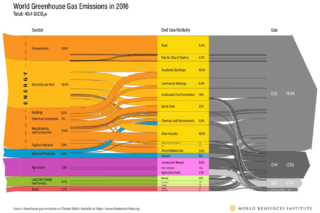-
So what’s the ‘Big Idea’?
Date posted:
-
-
-
Post Author
Philip SharmanIFRF Director
-
-
![]()
Arguably, in climate change, Humankind is facing the greatest existential threat it has ever faced, and, in moving to ‘net-zero’ emissions of greenhouse gases by the middle of this century, it is facing one of the toughest challenges of all time. So what’s the ‘big idea’ (or what are the big ideas) that will get us there?
One of my other jobs (besides being IFRF Director) is as the Chair of an Industrial Advisory Board for an initiative called the Energy Research Accelerator (ERA) in the UK – a collaboration of Midlands universities and the British Geological Survey aiming to ‘accelerate’ the development and commercialisation of key energy technologies needed to get to net zero. One of the ways that ERA works is by collaboratively developing ‘Big Ideas’ and testing these with the IAB (although this actually works the other way round too!).
The net-zero challenge is so big that we are going to need a whole host of big ideas! It’s also a global challenge and one that needs to engage all sectors of society, so some of those big ideas will be country or region specific, others will be economic-sector specific.
In thinking about such big ideas, it is probably helpful to ‘frame’ our thinking in terms of where the GHG emissions come from (sector-wise). While the Intergovernmental Panel on Climate Change (IPCC) ‘methodology’ is undoubtedly the most authoritative approach to categorising GHG emissions by economic sector (i.e. the IPCC Working Group III approach), it all gets a bit complex for a blogpost like this due to its consideration of direct and indirect emissions. As an engineer, I’m partial to a good old ‘Sankey’-style diagram, and the presentation of the same data that drives the IPCC analysis by the World Resources Institute using this approach, provides a much clearer ‘visualisation’ to my mind – there is even an ‘interactive chart’ version’ that you can play with! For reference, I’ve shown the ‘static chart’ version below.
![]()
IFRF members’ interests span the majority of the economic sectors on the left-hand side of the chart (with the possible exceptions of ‘Agriculture’ and ‘Land Use Change & Forestry’ – or ‘AFOLU’ as the IPCC aggregates and designates it). Similarly, the majority of the end uses and activities in the middle of the chart, and all of the GHGs on the right-hand side of the chart (plus other, non-GHG emissions too!), are of interest.
So, under these various categories, what are some of the ‘big ideas’ that I think could well hold answers for the future…
Electricity and heat production
Well, for electricity, the simple answers for getting to net zero by 2050 are more generation from renewable sources (notably wind, solar, biomass, hydropower and geothermal) – subject to the well-understood ‘intermittency’, ‘seasonality’ and economic resource constraints of some of this generation – and more nuclear power. For heat, the simple options are much more limited – renewable heat from biomass and solar heating systems.
Carbon capture and storage (CCS) applied to fossil-fuel-fired power and heat generating plants can only really be considered as a ‘transition’ option – and probably only really in the context of natural-gas-fired plant – although such a transition period may well take several decades in certain countries. CCS on combined-cycle gas/combustion turbine (CCGT) plant has been the subject of considerable R&D in recent years, with selective exhaust gas recirculation offering attractive solutions (see our TOTeM45 in Cardiff in 2018 which covered this topic, amongst others).
Of course, CCS applied to biomass-firing power plants – i.e. so-called ‘bioenergy with CCS’ (BECCS) – offers the potential for ‘carbon-negative’ electricity production. Such a carbon-negative solution may well prove necessary (along with using carbon offsetting deals) to compensate for the intractable carbon emissions from certain economic sectors (e.g. ‘Agriculture’ and ‘Transportation – Aviation’). Considerable R&D is being undertaken, with companies such as Drax planning BECCS installations.
With much talk about the need for ‘circular economy’ thinking as part of our net-zero approach, the way in which we utilise our waste is becoming increasingly important. The ‘big idea’ here would certainly involve moving away from power-only schemes to combined heat and power (CHP) options (that move the dial on net cycle efficiency up from around 30% to around 80%), and from thermal treatment (i.e. incineration) and biological treatment (i.e. aerobic processes and anaerobic digestion), to advanced thermal treatment processes (i.e. pyrolysis, gasification and hybrid processes) producing power, heat and other chemicals, etc., and biomethane production.
Just on the subject of nuclear power, there is a lot of R&D activity going on around ‘small modular reactors’ (e.g. akin to those used to power nuclear submarines) and ‘advanced modular reactors’ (i.e. based on the ‘Generation 4’ suite of nuclear reactor designs). Interestingly, much of the thinking around utilising some of the higher temperature Gen4 cycles is aiming at the co-production of heat and power, power and hydrogen, or even industrial heat with no power generation at all – quite a departure from the previous generations of nuclear plant! The prospect of smaller, modular, nuclear fusion reactors is also making headlines, with considerable effort being deployed into developing spherical-tokamak-based magnetic confinement fusion reactor concepts (although such systems will not help us achieve net zero by 2050, they may well offer sustainable power generation options in the second half of this century). For the record, I’m a keen advocate of both AMR nuclear fission technology and nuclear fusion.
A key ‘enabling technology’ for much of the above is energy storage technologies. While we are seeing a lot of demonstration and deployment of grid-scale (‘00s of MW/MWh) short-duration electrical energy storage (EES), there will be an increasing need for large-scale (GW/GWh) medium-duration EES, as well as intra- and inter-seasonal thermal energy storage (TES). Perhaps one of the ‘big ideas’ will see the optimised integration of EES with TES – perhaps around so-called ‘Carnot batteries’…
We have talked a lot about hydrogen (and hydrogen surrogates such as ammonia) in recent IFRF blogposts, and the potential for this fuel and energy vector to play an increasing role in our energy systems. We have explored the transition role for ‘blue’ hydrogen (i.e. from fossil fuel sources with CCS) on a pathway to ‘green’ hydrogen, too, and the possible use of ammonia as a fuel in CCGTs and CHP engines.
Perhaps the ‘big idea’ here would be to develop an integrated approach to low-carbon electricity generation – perhaps renewables (particularly offshore wind) together with nuclear – to provide further system benefits to the net-zero economy. Such integration could well mean the potential coupling/integration with other vectors (energy storage, hydrogen, etc.)?
Or maybe the ‘big idea’ revolves around the decarbonisation of heat and creating flexible local energy systems? This would likely bring a lot of smaller combustion processes and fuels into play.
Transportation
According to the Sankey-type diagram above, the next biggest economic sector is ‘Transportation’, with ‘Road Transport’ representing the main end use.
We have explored the main options for road vehicles in various IFRF blogposts in recent years, i.e. biofuels, electrification (i.e. electric vehicles, ‘EVs’) and hydrogen vehicles (i.e. fuel cell electric vehicles, ‘FCEVs’). The main direction of travel (if you will excuse the pun) for lighter vehicles is currently EVs (with hybrid EVs really only a transition technology to ‘pure’ EVs), although their widespread deployment will clearly prove challenging in terms of infrastructure roll-out, rapid charging in urban environments and the impact on the electricity energy system. FCEVs for light vehicles may well also gather pace, although the short-term infrastructure challenges (i.e. around hydrogen storage and refuelling stations) are arguably even greater than for EVs.
My personal view is that hydrogen fuel cell systems may very well prove a better solution in the heavy goods vehicle sector, and we are already seeing their deployment in buses, trains, ships, etc.
Aviation is a problematic area in terms of moving towards net-zero emissions. Again, we have looked at the various options – biofuel-based ‘Sustainable Aviation Fuel’ as an alternative to kerosene, electric motors, hydrogen – and much activity is ongoing to address this sector. Once the world recovers from the current coronavirus Covid-19 pandemic, it will be interesting to see how much our addiction to flying (or indeed the airlines to fly with) change.
Industrial processes, and manufacturing and construction
IFRF’s ‘remit’ of industrial combustion makes these economic sectors of particular importance to our members. Following the ‘flows’ on the Sankey-style diagram though to the end uses and activities, the main areas of interest to us are clearly ‘Iron & Steel’ manufacturing, the ‘Chemical & Petrochemical’ industries and ‘Cement’ production, although ‘Other Industry’ is still significant in terms of the GHG emissions produced.
Many of the technical options described above – CCS, hydrogen or hydrogen-rich fuels and vectors, electrification, etc. – will be important (separately or integrated together) in providing decarbonisation pathways in these economic sectors, as will other fuels, fuel switching, energy and resource efficiency, and sector-specific innovative processes. Combustion, burners, fired heaters, boilers and flaring (all key topics of interest to IFRF) are important in these sectors.
Energy efficiency
The last point above reminds me of a key ‘big idea’ that we tend to overlook – energy efficiency! Using less energy to start with in all of the above sectors is clearly a ‘no-brainer’, as this solution often offers the lowest cost of implementation and, generally, financial benefits that give a pay-back on any investment made.
Have your say…!
IFRF members are involved in many/all of the above sectors and most of the various ‘big ideas’ I have pointed towards.
Why not have your say on the above ideas and others that you might add to the list?
We will be using our LinkedIn and Twitter social media channels to explore this further, so use this as an opportunity to join in with the conversation. I have only ‘scraped the surface’ on this topic – now it’s over to you!


